|
|
|
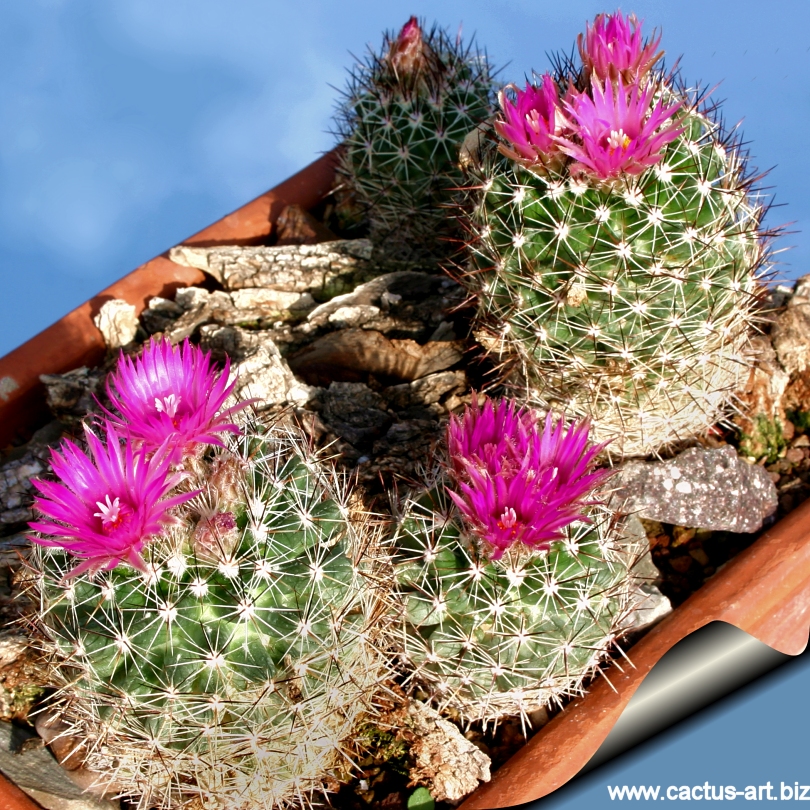
Escobaria vivipara RP113 FT Union New Mexico
|
|
Description: Escobaria vivipara is a small
solitary or clumping cactus. Some varieties form
colonies of over 200
stems. This species is the most widespread, abundant and variable member
of the genus. It is densely covered in a mat of star-shaped arrays of
spines.
Stems: Usually more than 1/2 above ground (sometimes deep-seated
and flat-topped in winter, in cold climates and/or in immaturity),
spheric, ovoid, obovoid, or cylindric with age, 2.5-75 × 3-11 cm tall;
Tubercles: Grooved, 8-25 × 3-8 mm, stiff or ± flaccid; areolar
glands absent.
Roots: ± diffuse, less than 1/4 of stem diameter.
Spines: 11-55 per areole; either bright white, ashy white, pale
tan, pale pinkish gray, or reddish brown (rarely stramineous), tips dark
bright pinkish brown, reddish brown, dark brown, orange-brown, or
pinkish orange, purplish gray, pinkish gray, brownish red, sepia dark
purplish brown, or stramineous, opaque or vitreous, fading, then
blackening with age (dark tips rarely absent).
Radial spines: 10-40 per areole, weakly appressed or tightly
appressed, pectinately arranged in subadults of some populations, 7-22
mm long. Subcentral spines
are sometimes present.
Central spines: Straight; outer central spines 3-14 per areole; appressed or strongly projecting, in "bird’s-foot" arrangement or
radiating like spokes, longest spines 9-25 mm.
Flowers: Subapical, 20-65(-90?) mm long; outer tepals
conspicuously fringed; pale rose-pink to reddish pink or magenta (or
rarely yellow or green) , sometimes with darker midstripes, sometimes
shading to white or pale green,
Fruits: Green, exposed portions slowly turning dull brownish red,
ovoid to obovoid, 12-28 × 7-20 mm, juicy; floral remnant persistent.
Seeds: bright reddish brown, comma-shaped or nearly obovoid,
(1-)1.3-2.4(-3) mm.
Flowering season: Spring-late summer; fruiting 2-5 months after
flowering.
|
|
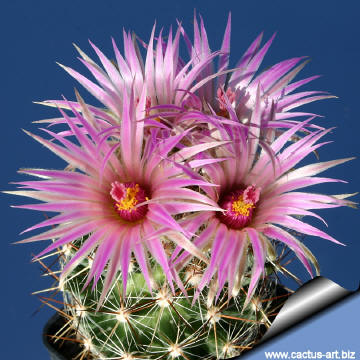 |
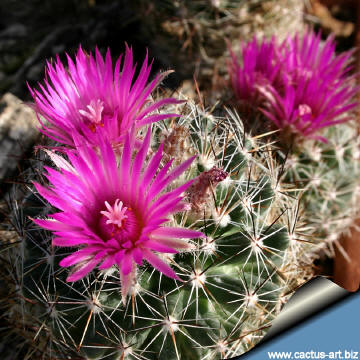 |
|
. |
|
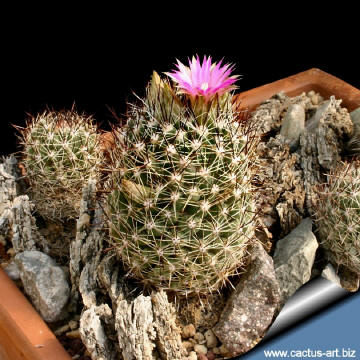
|
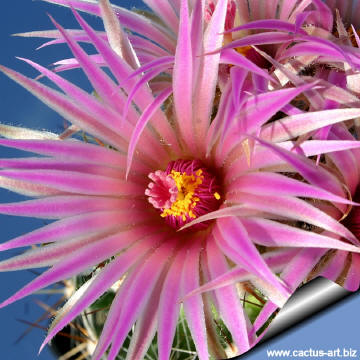
|
|
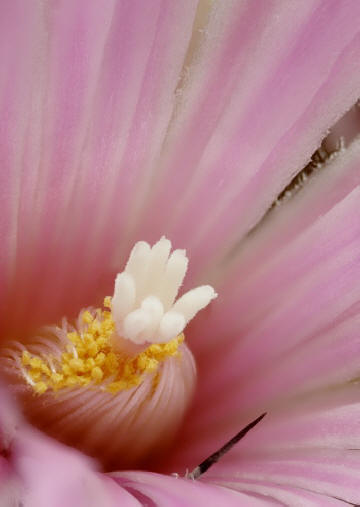
Photo &
©
copyright
by
Irwin Lightstone
Images may not be copied,
downloaded, or used in any way without the expressed, written permission
of the photographer.
|
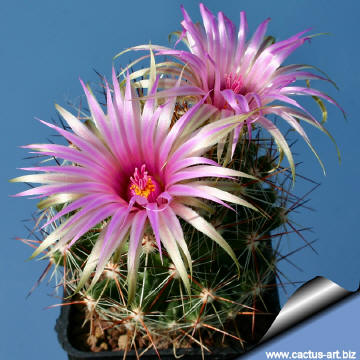
Escobaria vivipara
SB383 Howard County, Texas, USA
Notes: The showy flowers of Escobaria vivipara are
virtually identical to those of
Coryphantha macromeris and
Mammillaria wrightii; in the absence of vegetative material,
flowers may be unidentifiable. Some unrelated species, such as
Coryphantha echinus, vegetatively resemble.
|
|
Cultivation:
It comes from an area
of
summer
rainfall.
Keep
drier
in
winter (but for
outdoor cultivation it is very resistant to wet conditions,
too). It needs good drainage.
Very cold resistant, but the frost resistance varies a
lot from clone to clone. It
can easily
be
grown outdoors
in areas with minimum winter temperatures of -15 -25°
(but
northern populations from Canada are resistant to -35
-45°C).
It needs
full sun to light shade.
Propagation:
Seeds (no
dormancy requirement, they
germinate best at 25°C) or by
offsets (if
available),
or
occasionally
grafted.
|
|


Advertising
|
|
|
|
|
Family:
Cactaceae
(Cactus Family)
Scientific name:
Escobaria vivipara
(Britton & Rose)
In N. L. Britton and A. Brown Ill. Fl. N. U.S.,
ed. 2. 2: 571. 1913.
Origin:
Large parts of USA (Ariz., Calif., Colo., Kans., Minn.,
Mont., Nebr., Nev., N.Mex., N.Dak., Okla., S.Dak., Tex., Utah, Wyo)
Canada (Alta., Man., Sask.). Mexico (Chihuahua, Coahuila,
Sonora).
Reports of it from Oregon, Idaho, and northern Utah are incorrect
Habitat: Desert scrub to conifer forest, mostly low hills or
mountain tops, diverse substrates; 200-2700 m.
Conservation status: Listed in
CITES appendix 2.
Common Names include: Beehive Cactus, Spinystar,
Pincushion cactus, and viviparous foxtail cactus.
Synonyms:
- Escobaria vivipara (
Basionym: Cactus viviparus
Nuttall, Cat. Pl. Upper Louisiana, no. 22. 1813,
Mammillaria vivipara,Echinocactus viviparus,
- Escobaria neo-mexicana (Coryphantha vivipara var. neo-mexicana,
Cactus radiosus var. neo-mexicanus, Mammillaria radiosa var.
neo-mexicana, Coryphantha radiosa var. neo-mexicana, Cactus neo-mexicanus,
Mammillaria vivipara var. neo-mexicana, Mammillaria neo-mexicana,
Escobaria vivipara var. neo-mexicana, Coryphantha neo-mexicana,)
- Escobaria vivipara var. radiosa (Escobaria radiosa,
Neomammillaria radiosa, Mammillaria radiosa, , Coryphantha
radiosa, Coryphantha vivipara var. radiosa,Cactus radiosus,
Echinocactus radiosus, Mammillaria vivipara var. radiosa)
- Escobaria vivipara var. rosea (Coryphantha rosea,
Coryphantha vivipara var. rosea, Coryphantha vivipara var. kaibabensis,
- Escobaria vivipara var. arizonica (Engelmann) W. T.
Marshall
(Mammillaria arizonica, Mammillaria vivipara var. arizonica,
Coryphantha vivipara var. arizonica, Mammillaria radiosa var.
arizonica, Escobaria arizonica, Coryphantha arizonica, Cactus radiosus
var. arizonicus )
- Escobaria vivipara var. kaibabensis (C. vivipara var.
kaibabensis)
- Escobaria vivipara var. fragrans (Coryphantha fragrans)
- Escobaria vivipara var. bisbeeana (Coryphantha bisbeeana,
Escobaria bisbeeana, Coryphantha vivipara var. bisbeeana)
- Escobaria vivipara var. buoflama (Coryphantha
vivipara var. buoflama)
- Escobaria vivipara var. columnaris (Coryphantha
columnaris)
- Escobaria vivipara var. marstonii (Coryphantha
missouriensis var. marstonii)
- Escobaria vivipara var. oklahomensis (Coryphantha
oklahomensis)
|
|
|
|
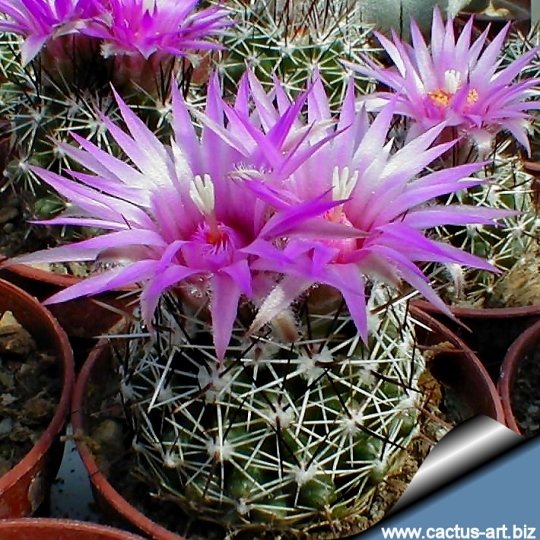
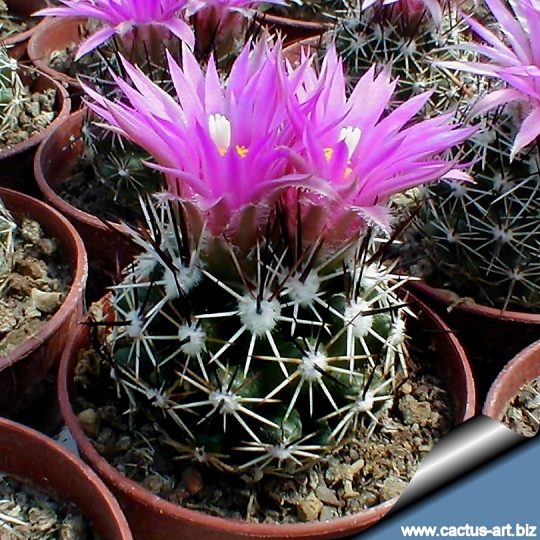
|
|
There are a number of varieties of this highly variable cactus species,
but not all are universally recognized. Some authorities recognize the
following varieties:
- E. vivipara var. arizonica (Arizona spinystar) - native to
the desert southwest of the United States
- E. vivipara var. bisbeeana (Bisbee spinystar) - native to
Arizona and New Mexico
- E. vivipara var. deserti (desert spinystar) - found in the
desert southwest
- E. vivipara var. kaibabensis (Kaibab spinystar) - mostly
limited to Arizona
- E. vivipara var. neomexicana (New Mexico spinystar) -
native to New Mexico and Texas
- E. vivipara var. vivipara - known as far north as Manitoba
and also:
- E. vivipara var. radiosa
- E. vivipara var. rosea
|
|
Photo of
conspecific taxa, varieties, forms and cultivars of Escobaria
vivipara.
|
|